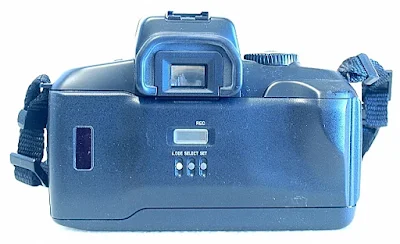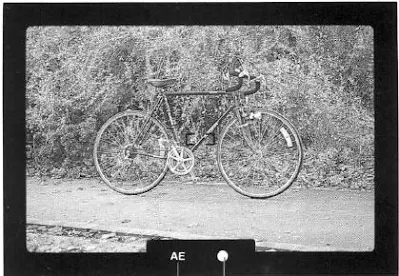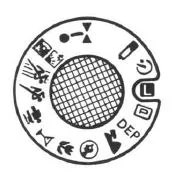Film Camera Review: A look back at the EOS 700 QD, an advanced autofocus EOS 35mm SLR film camera from Canon.
The camera, seen here mounted with a Canon EF 40mm F2.8 STM pancake lens, complete with its auto self-retracting flash, Evaluative Metering, and Intelligent Picture Modes, is an excellent camera to own and a pleasure to use.
While the first two entry-level models of the EOS System, the EOS 750/850 (with and without flash) were without any manual controls at all, the 700QD was updated with databack buttons, flash off/auto switch, 2nd generation AF system as used on the very advanced Canon EOS 630, and a reversible mode dial with program modes selection on one side, and shutter speed on the other.
The reversible mode dial system, unique to the EOS 700QD, allows the camera to be used with a range of AE programmed modes as the first option, and on the other hand, a fully automatic shutter-priority AE camera.
My EOS Film Cameras
The Canon EOS film camera lineup provides great accessible film camera options for anyone looking to jump into film photography. In this video I share my col...
The EOS 700QD, fitted with a vertical-travel metal focal-plane shutter, has a speed range from 1/4 to 1/2000 second, plus Bulb. The camera will accept a film with an ISO speed rating from 25-3200, which is automatically set in DX-coded 1-step increments. The manual film ISO setting, however, is not available on the camera, and the non-DX-coded film will default to ISO 25.
Basic Camera Features
For exposure control, the EOS 700QD uses a sophisticated 6-zone Evaluative Metering system that compares lighting values in various areas of the scene for the best possible exposure, automatically selects partial or center-weighted average metering, and may go a step further and fine-adjust the exposure to suit the focal length setting of the zoom lens you are using.
Looking a bit like a hulk, albeit a nice one, and built with a sturdy sculptured bakelite body shell, the camera has a simple front plane arrangement of the handgrip/battery compartment occupying almost all of the left front, and centrally, the lens housing mounts with the lens release button on its side.
On the left of the pentaprism hump of the top plane is the flash unit Off/Auto switch, with the pop-up flash unit and a hot shoe on the hump itself. To the right, the Program Mode dial, film counter window, and the shutter release button are forward on the sloped hand grip.
On the back, the back portion of the sculptured handgrip on the film back itself, a centrally located film data panel and selection buttons, a film ID window, and on the back of the top plane, the viewfinder eyepiece.
The EOS 700QD has a simple ribbed bottom with only the tripod socket present.
A quick-load film box similar to what we can find on other AF film cameras of this era.
Film Loading and Rewinding
The Canon EOS 700QD uses the pre-wind system for its film loading and rewinding. When first loaded, the whole length of the film roll is spooled forward by the take-up spool and wound back into the film canister as each shot is taken.
Viewfinder Readout
The viewfinder readout, from a fixed pentaprism display with 92% horizontal and vertical coverage, is a clear and unobstructed display of the image frame, with only the AF spot bracket etched in the middle of the screen, and a pair of LED indicators in a notch on the lower part of the display.
The first indicator, on the left, is the 'AE' exposure indicator, and on the right, a Green LED dot for in-focus information.
Exposure Mode Selection
At the heart of the EOS 700QDF's operation, the Exposure Mode Selection dial of the EOS 700QD provides a total of 10 exposure mode selections in addition to the Intelligent Program AE setting.
- P [Intelligent Program AE] - Works like a conventional auto-exposure program mode by automatically selecting the appropriate aperture value and shutter speed for each shooting situation. But the EOS system also fine-adjusts the setting to suit the lens and focal length of the zoom lens used.
- DEP [Depth of Field AE] - A setting of two specific points, a foreground point and a background point, between which the image will be in focus. This is a three-step process where you use the shutter release button to first pick the foreground point, next, the background point, and after reframing the image, the final shutter release.
- Landscapes - Where you want all of the images to be in focus.
- Portrait - Where you want to keep the object in focus, sharp with a blurry background.
- Close-Up - Where you want to shoot subjects that are close to the camera.
- Indoor - Generally for group or indoor shots with flash mode assist.
- Deep Focus - Where you want to keep both foreground and background sharp.
- Stop Action - Where you want to freeze the action of moving subjects.
- Panning - Where you want to follow the path of the subject while pressing the shutter button, and getting a blurred background.
- Slow Sync/Fill-in Flash - In backlight situations or where subjects are heavily shaded.
- Focus Preset Mode - Where you want to lock the camera to a single focus lock distance for consecutive or multiple shots. A two-button-step operation. First is to set the dial to the 'DOT' and lock the focus distance by half-pressing the shutter release button, and then locking the distance by turning the dial to the pointed arrows '><' position before taking the sequence of shots.
The two additional dial points above the Camera Lock selection are the Battery Check flip-switch and Self-Timer. The camera will emit a continuous beep when the flip switch is engaged to indicate that the battery has sufficient power to operate the camera. The Self-Timer will delay the shutter release for 10 seconds.
Shutter-Priority AE
In shutter-priority AE, with the mode selector dial reversed, the camera will choose the correct aperture opening of the lens for correct exposure at the selected shutter speed setting.
The shutter-priority AE dial is also etched with the Battery Check, Self-Time, Lock, and P (Intelligent Program AE), similar to the ones on the reverse side, while the rest of the dial is etched with selectable shutter-speed settings, from 1/2000 to 1/4 second, and B for time exposure shots. No other shutter speed setting is available in this mode.
Flash Off/Auto
An interesting feature of the Canon EOS 700QD is the built-in TTL flash unit when set to Auto mode, which pops up and retracts automatically when taking a shot. The flash is capable of covering the field of view of a 35mm lens and has a 2-second recycling time.
Battery
The camera requires a 2CR5 Lithium battery pack to power its operation. The battery compartment is located on the front part of the handgrip, accessed via a lug-screwed panel on the side of the camera's body.
Camera Body Weight
The Canon EOS 700QD is solidly built with a sculptor's bakelite outer skin and weighs in at 655 grams with a battery installed.
Using the Camera
While doing the review of the camera and the photo assignments, I had the chance to test the compatibility of the Canon EOS 700QD (1990), backward with an EF-mount Sigma Zoom AF 21-35mm F3.5-4.2 (1985), and forward with the Canon EF 40mm F2.8 STM (2012). Lo and behold, despite the years between their production timeline, everything seems to work in perfect unison.
Thanks to the well-built and ergonomic design, it takes almost no effort to lug the EOS 700QD around, or with it strapped to your hand, with either the bulky Sigma Zoom AF or the pancake EF Canon STM. The shutter release and mirror flap are smooth and well-damped, with absolutely no notion of any camera shake, if any, and Canon’s Stepper Motor technology for the 40mm F2.8 STM, which makes it all quieter and smoother, is the icing on the cake.
Against the bulk of the Sigma Zoom AF and its 72mm front element and built-in hood, the 40mm STM is all but just a protrusion of the camera body, even shallower than your knuckles with your fingers over the handgrip. Holding the camera at arm's length, above your head or into the crowd, or shooting hipster style, with the camera's excellent autofocus and intelligent program modes, will get you going well.
Canon EOS System Camera Compatibility
The strength of the EOS camera system, one of its most endearing qualities, is the across-the-board compatibility between all EOS bodies, whether analog or digital, to all Canon EF-mount lenses ever produced (including the new EOS M series when used with the EF to EOS M Mount adapter). Hooking one up with the other, or vice versa, is never a problem, and taking the concept of the 'one lens, two systems' to reality is never a question.
Even a low-priced EOS 700QD, like the one I was testing, is as good as any to start the quest.



























No comments:
Post a Comment